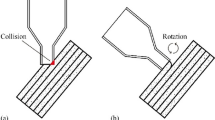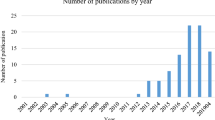Abstract
In this study, a bi-objective scheduling problem of a flexible robotic cell is considered aiming to a trade-off between cell’s processes scheduling and the production cost. At the cell, machines are identical and parallel and in line. There is an input buffer for the raw materials and an output buffer for the products. A robot is in charge of loading and unloading of the items from the input buffer to machines and from machines to the out put buffer. The system is cyclic means repeats the same processes in every cycle. It is assumed that each machine processes one part in each cycle. A bi-objective mathematical model is presented to solve the problem, and as an alternative, an NSGAII is developed for large-sized problems. Several numerical examples are solved for examining the proposed mathematical model and NSGAII method.
Similar content being viewed by others
References
Barenji RV, Barenji AV, Hashemipour M (2014) A multi-agent RFID-enabled distributed control system for a flexible manufacturing shop. Int J Adv Manuf Technol 71(9–12):1773–1791
Mosallaeipour S, Ghadiri Nejad M, Shavarani SM, Nazerian R (2017) Mobile robot scheduling for cycle time optimization in flow-shop cells, a case study. Prod Eng. https://doi.org/10.1007/s11740-017-0784-x
Crama Y, Van de Klundert J (1999) Cyclic scheduling in 3-machine robotic flow shops. J Sched 2(1):35–54
Brauner N, Finke G (2001) Cycles and permutations in robotic cells. Math Comput Model 34(5–6):565–591
Abdekhodaee AH, Wirth A, Gan HS (2004) Equal processing and equal setup time cases of scheduling parallel machines with a single server. Comput Oper Res 31(11):1867–1889
Dawande M et al (2005) Sequencing and scheduling in robotic cells: recent developments. J Sched 8(5):387–426
Gultekin H, Akturk MS, Karasan OE (2008) Scheduling in robotic cells: process flexibility and cell layout. Int J Prod Res 46(8):2105–2121
Yildiz S, Karasan OE, Akturk MS (2012) An analysis of cyclic scheduling problems in robot centered cells. Comput Oper Res 39(6):1290–1299
Ghadiri Nejad M, Kovacs G, Vizvari B, Vatankhah Barenji R (2017) An optimization model for cyclic scheduling problem in flexible robotic cell. Int J Adv Manuf Technol. https://doi.org/10.1007/s00170-017-1470-z
Ghadiri Nejad M, Güden H, Vizvári B, Vatankhah Barenji R (2017) A mathematical model and simulated annealing algorithm for solving the cyclic scheduling problem of a flexible robotic cell. Adv Mech Eng. https://doi.org/10.1177/1687814017753912
Cochran JK, Horng SM, Fowler JW (2003) A multi-population genetic algorithm to solve multi-objective scheduling problems for parallel machines. Comput Oper Res 30(7):1087–1102
Xia W, Wu Z (2005) An effective hybrid optimization approach for multi-objective flexible job-shop scheduling problems. Comput Ind Eng 48(2):409–425
Tavakkoli-Moghaddam R, Rahimi-Vahed A, Mirzaei AH (2007) A hybrid multi-objective immune algorithm for a flow shop scheduling problem with bi-objectives: weighted mean completion time and weighted mean tardiness. Inf Sci 177(22):5072–5090
Chang PC, Hsieh JC, Lin SG (2002) The development of gradual-priority weighting approach for the multi-objective flowshop scheduling problem. Int J Prod Econ 79(3):171–183
Yagmahan B, Yenisey MM (2008) Ant colony optimization for multi-objective flow shop scheduling problem. Comput Ind Eng 54(3):411–420
Yagmahan B, Yenisey MM (2010) A multi-objective ant colony system algorithm for flow shop scheduling problem. Expert Syst Appl 37(2):1361–1368
Zhang G, Shao X, Li P, Gao L (2009) An effective hybrid particle swarm optimization algorithm for multi-objective flexible job-shop scheduling problem. Comput Ind Eng 56(4):1309–1318
Rahmati SHA, Zandieh M, Yazdani M (2013) Developing two multi-objective evolutionary algorithms for the multi-objective flexible job shop scheduling problem. Int J Adv Manuf Technol. 1–18
Karthikeyan S, Asokan P, Nickolas S (2014) A hybrid discrete firefly algorithm for multi-objective flexible job shop scheduling problem with limited resource constraints. Int J Adv Manuf Technol 72(9–12):1567–1579
Lei D (2009) Multi-objective production scheduling: a survey. Int J Adv Manuf Technol 43(9–10):926–938
Yenisey MM, Yagmahan B (2014) Multi-objective permutation flow shop scheduling problem: literature review, classification and current trends. Omega 45:119–135
Holland JH (1973) Genetic algorithms and the optimal allocation of trials. SIAM J Comput 2(2):88–105
Deb K, Agrawal S, Pratap A, Meyarivan T (2000) A fast elitist non-dominated sorting genetic algorithm for multi-objective optimization: NSGA-II. In International Conference on Parallel Problem Solving From Nature (pp. 849–858). Springer, Berlin
Coello C, Lamont G, Van Veldhuisen D (2007) Evolutionary algorithms for solving multi-objective problems. Spring. https://doi.org/10.1007/978-0-387-36797-2
Hwang CL, Masud ASM (1979) Multiple objective decision making, methods and applications: a state-of-the-art survey. In Collab. with SR Paidy and K. Yoon. Springer-verlag
Hajela P, Shih C-J (1990) Multiobjective optimum design in mixed integer and discrete design variable problems. AIAA J 28(4):670–675
Shavarani SM, Ghadiri Nejad M, Rismanchian F, Izbirak G (2017) Application of hierarchical facility location problem for optimization of a drone delivery system: a case study of Amazon prime air in the city of San Francisco. Int J Adv Manuf Technol. https://doi.org/10.1007/s00170-017-1363-1
Golabi M, Shavarani SM, Izbirak G (2017) An edge-based stochastic facility location problem in UAV-supported humanitarian relief logistics: a case study of Tehran earthquake. Nat Hazards 1–21
Author information
Authors and Affiliations
Corresponding author
Rights and permissions
About this article
Cite this article
Ghadiri Nejad, M., Shavarani, S.M., Vizvári, B. et al. Trade-off between process scheduling and production cost in cyclic flexible robotic cells. Int J Adv Manuf Technol 96, 1081–1091 (2018). https://doi.org/10.1007/s00170-018-1577-x
Received:
Accepted:
Published:
Issue Date:
DOI: https://doi.org/10.1007/s00170-018-1577-x




